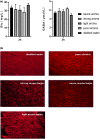Evaluating and forecasting the associated main flavor components in Baijiu (Chinese distilled spirits) with alcohol metabolism and hangover symptoms through mice acute withdrawal model
- PMID: 36655102
- PMCID: PMC9834859
- DOI: 10.1002/fsn3.3064
Evaluating and forecasting the associated main flavor components in Baijiu (Chinese distilled spirits) with alcohol metabolism and hangover symptoms through mice acute withdrawal model
Abstract
Over the past few decades, more alcohol-problem concerns focused on reducing the risk of hangover caused by the alcoholic beverages over-consumption. Chinese distilled spirits (Baijiu) is one of the most favorite alcoholic beverages. The intention of this study is to explore the associations of main flavor components in Baijiu and hangover symptoms using mice acute alcohol withdrawal model. The behaviors of each mouse were assessed by open-field tests using separate groups of mice with the treatment of sauce-aroma Baijiu, light-aroma Baijiu, strong-aroma Baijiu, pure alcohol, and distilled water, respectively. The behavioral data including total move distance and immobile time were used as indicators for the evaluation of the liquor intoxicating effects. Alcohol and acetaldehyde concentrations in mice plasma and the neurotransmitter contents of GABA and Glu in mice cerebellum were detected afterward. The results showed that the mice with the treatment of Baijiu samples displayed unusual exciting behaviors including increased alcohol metabolization with alleviating drunken and hangover symptoms, compared with that of pure alcohol control groups after 2-4 h. Moreover, the sauce-aroma Baijiu treatment group showed lessening intoxicated symptoms than those of light-aroma Baijiu and strong-aroma Baijiu. In addition, there were significant differences between Baijiu and pure alcohol treatment groups at the inhibitory neurotransmitter GABAergic levels and its receptor GABA-AR1 activating levels in the mice neuron cells. Furthermore, the Principal Component Analysis (PCA) analysis inferred that the flavor compounds acetic acid, ethyl acetate, ethyl lactate, and 1-propanol in the sauce-aroma Baijiu were played the major roles in the drunk behaviors that caused by the hangover. While, the acetic acid in the sauce-aroma Baijiu was speculated as a major flavor component to accelerate the alcohol metabolism and retard hangover symptoms.
Keywords: Baijiu (Chinese distilled spirits); alcohol metabolism and hangover symptoms; main flavor compounds; mice acute withdrawal model.
© 2022 The Authors. Food Science & Nutrition published by Wiley Periodicals LLC.
Conflict of interest statement
The authors declare no conflict of interest.
Figures




Similar articles
-
Insights into the Aroma Profile of Sauce-Flavor Baijiu by GC-IMS Combined with Multivariate Statistical Analysis.J Anal Methods Chem. 2022 Mar 29;2022:4614330. doi: 10.1155/2022/4614330. eCollection 2022. J Anal Methods Chem. 2022. PMID: 35392280 Free PMC article.
-
What Are the Main Factors That Affect the Flavor of Sauce-Aroma Baijiu.Foods. 2022 Nov 7;11(21):3534. doi: 10.3390/foods11213534. Foods. 2022. PMID: 36360147 Free PMC article. Review.
-
Characteristics and correlation of flavor substances and hangover indexes in Chinese baijiu during storage.Curr Res Food Sci. 2024 Oct 15;9:100887. doi: 10.1016/j.crfs.2024.100887. eCollection 2024. Curr Res Food Sci. 2024. PMID: 39498460 Free PMC article.
-
Changes in flavor profile of sauce-flavor baijiu: Perceptual interactions between 1-propanol and aroma compounds.Food Chem X. 2025 Jan 2;25:102153. doi: 10.1016/j.fochx.2024.102153. eCollection 2025 Jan. Food Chem X. 2025. PMID: 39867214 Free PMC article.
-
Research progress of trace components in sesame-aroma type of baijiu.Food Res Int. 2020 Nov;137:109695. doi: 10.1016/j.foodres.2020.109695. Epub 2020 Sep 16. Food Res Int. 2020. PMID: 33233269 Review.
References
-
- Cai, X. M. , Shen, Y. , Chen, M. Y. , Zhong, M. G. , & Luo, A. (2019). Characterization of volatile compounds in Maotai flavour liquor during fermentation and distillation. Journal of the Institute of Brewing, 125(4), 453–463. 10.1016/j.foodres.2019.02.044 - DOI
-
- Gao, W. J. , Fan, W. L. , & Xu, Y. (2014). Characterization of the key odorants in light‐aroma type Chinese liquor by gas chromatography olfactometry, quantitative measurements, aroma recombination, and omission studies. Journal of Agricultural and Food Chemistry, 62(25), 5796–5804. 10.1021/jf501214c - DOI - PubMed
LinkOut - more resources
Full Text Sources
Miscellaneous

